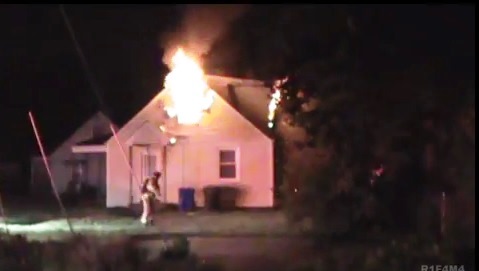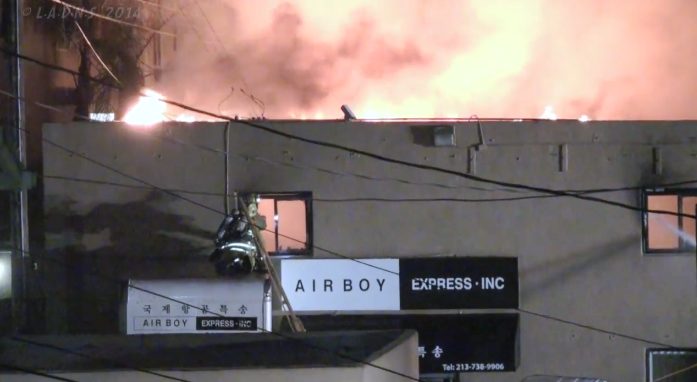More citizen complaints: 'We lost our home. They were supposed to save our home.' Comparing TV news coverage from fires in Utica and Buffalo.
Previous coverage of Utica fire
The headline is a quote taken from the video above. It comes from a woman whose family lost its home to a fire on Humboldt Parkway in Buffalo, New York Wednesday afternoon. "They were supposed to save our home" shows that expectations are often high that the fire department is going to come in and save the day.
Much like the deadly fire in Utica on Monday, this is another example of citizens making claims that firefighters didn't do enough. Should reporters have aired or published the allegations made in either of these stories and how should a fire department respond?
In one of these cases I think the news people got it right and in the other, while they really tried to be fair and balanced, they blew it. In both incidents I give the fire department response high marks.
As you probably recall from the Utica story, photojournalist Tim Fisher went the extra step to look beyond the sound bites of distraught family and friends and put the allegations in perspective with a more than six minute story that ran the day after the fire (see the story below).
What Tim Fisher did is not the norm for TV news. Management usually doesn't give the time to reporters and photographers to piece something like that. And six minutes is more than four minutes longer than the usual TV story. Fisher is also a veteran. He's a 63-year-old newsman who previously worked in Minneapolis. His experience gave him the knowledge of how fire departments work and how these stories play out.
The story from Buffalo (at the top of this post) is a much more typical TV news story. It lasts about two minutes and was put together under a much tighter deadline. A husband and wife, after losing their home and all of their possessions, question firefighting tactics. They are upset over how fast water was applied to the fire and make claims about hydrants not being used.
The presentation is actually quite balanced in that it makes sure the response from Buffalo Fire Department officials is not only in the story itself but summarized in the lead-in by both the anchors and the reporter. The Buffalo Fire Department points out they were making an aggressive interior attack when firefighters began receiving electrical shocks. They then switched to a defensive operation. One captain was hospitalized with burns.
But here is where I am critical of this story. There is no there there.
Making sure that all sides impacted by a story are heard is an important part of journalism. Tim Fisher told us, and I agree, that part of the job is to give voice to those who might not otherwise have one and ask the important questions.
The other part of the reporter's job is to investigate those allegations and see if there is merit. A reporter should verify if there is actually validity to the claim. People say a lot of things. That doesn't mean it's true and that all of it should be on television or in the newspaper. A reporter's job is to try and determine what is really relevant to the story. In the Buffalo case I am not sure the reporter did that good of a job.
I say this because the reporter didn't show us a bit of evidence to back up the allegations that there was a delay in applying water or that nearby hydrants weren't used. A cell phone from the couple with a video on it is held up to the TV camera, but it shows us nothing. The WIVB-TV reporter says in the story, "Several hydrants sit adjacent to the dwelling and appeared untouched". What exactly does a "touched" hydrant look like a day after a fire?
Video from another station (below) shows some master streams and a lot of lines. They were getting water from somewhere. If these claims were true, the reporter didn't convince me.
When I worked in TV news I dealt with this same scenario countless times (and I imagine I mishandled it once or twice). Usually it was about what took the fire department so long to get there. I did my best to check out each one. In 95 percent of the cases (a very, very rough estimate by me) there was no evidence to back up the allegations and it never made my story. In the other five percent I aired the claims, but tried to put them in perspective and show other evidence that there was some validity to what the people were saying.
The Utica story would be a tougher call for me. That one is the much harder one to ignore completely in your story. It is a much more significant event with an enormous amount of emotion. Looking at the extensive coverage by WKTV-TV on the day of the fire, I liked that they mentioned the criticism but did not make it the focus of their coverage. The addition of Tim Fisher's story though, put it all in perspective.
What I was particularly impressed with in both stories is that the fire departments didn't run from these allegations. They addressed them head-on and did so with a great deal of sensitivity and compassion toward the victims. Plus, they made sure their response was part of the original story and not a day or more later. Just like Tim Fisher's story, you don't often see that.






